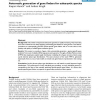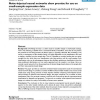BMCBI
2006
13 years 11 months ago
2006
Background: Concerns are often raised about the accuracy of microarray technologies and the degree of cross-platform agreement, but there are yet no methods which can unambiguousl...
BMCBI
2006
13 years 11 months ago
2006
Background: In order to maintain the most comprehensive structural annotation databases we must carry out regular updates for each proteome using the latest profile-profile fold r...
BMCBI
2006
13 years 11 months ago
2006
Background: Here we describe PathogenMIPer, a software program for designing molecular inversion probe (MIP) oligonucleotides for use in pathogen identification and detection. The...
BMCBI
2006
13 years 11 months ago
2006
Background: Computational discovery of transcription factor binding sites (TFBS) is a challenging but important problem of bioinformatics. In this study, improvement of a Gibbs sa...
BMCBI
2006
13 years 11 months ago
2006
Background: Many of the most popular pre-processing methods for Affymetrix expression arrays, such as RMA, gcRMA, and PLIER, simultaneously analyze data across a set of predetermi...
BMCBI
2006
13 years 11 months ago
2006
Background: In the post-genome era, most research scientists working in the field of proteomics are confronted with difficulties in management of large volumes of data, which they...
BMCBI
2006
13 years 11 months ago
2006
Background: The number of sequenced eukaryotic genomes is rapidly increasing. This means that over time it will be hard to keep supplying customised gene finders for each genome. ...
BMCBI
2006
13 years 11 months ago
2006
Background: Overfitting the data is a salient issue for classifier design in small-sample settings. This is why selecting a classifier from a constrained family of classifiers, on...
BMCBI
2006
13 years 11 months ago
2006
Background: Microarray expression profiling has been widely used to identify differentially expressed genes in complex cellular systems. However, while such methods can be used to...
BMCBI
2006
13 years 11 months ago
2006
Background: Many DNA regulatory elements occur as multiple instances within a target promoter. Gibbs sampling programs for finding DNA regulatory elements de novo can be prohibiti...


